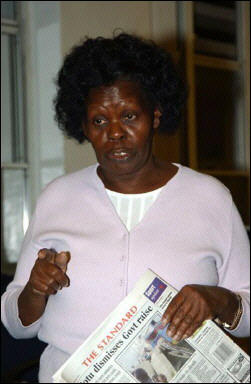By Charles Onyango-Obbo
As Kenya is being convulsed by post-election violence, many columnists and peace entrepreneurs have exhorted the people not to be misled by politicians.
They have argued that while hundreds of “innocent” poor Kenyans are killed and displaced, the children and grandchildren of the political leaders for whom they are fighting, are enjoying their sweet sleep in leafy suburbs, and continuing to go to expensive private schools in Nairobi and abroad.
The middle class, especially the politicians, have been condemned either for fanning violence or being complacent because it thinks the troubles will not come to the rich suburbs of Muthaiga, Gigiri, and so on.
Which begs the question, can the violent spiral ever come to Parklands or Muthaiga?
THE ANSWER LIES IN THE OTHER Congo, Congo Brazzaville. Some of the events in that central African country bear some uncanny similarities to what is happening in Kenya today:
In 1992, Congo’s dictator Sassou-Nguesso ended one-party rule by holding the country’s first multi-party elections. He lost the election to Pascal Lissouba.
Like Kenya’s election, the results were disputed. Afraid that Sassou-Nguesso would use his old military contacts to overthrow him, Lissouba formed his own militia, the Cocoyes.
Opposition leader Sassou-Nguesso responded by forming his own militia, the Cobras, and another opposition figure, Bernard Kolelas formed the Ninja.
The militias fought until 1994 when the warring parties accepted international mediation, and an all-out war was avoided. Sassou-Nguesso had all but bankrupted his country over the years he had been in power (from 1979), much the same way had happened to Kenya in the last 10 years of Kanu rule.
Under Lissouba, a Kibaki-type figure, Congo witnessed a modest economic recovery. Still, as the French newspaper Le Monde reported, daily life was becoming more and more difficult, particularly in the capital, Brazzaville.
Roads were in poor repair, fuel, gas, water and electricity in short supply, telephones cut off. The politicians, on the other hand, seemed to be getting richer all the time. People at every level of society were looking for patrons and protectors to enable them to share in the redistribution of wealth.
Lissouba’s government failed to achieve the electoral and constitutional reforms agreed in 1992. It slapped restrictions on the Press, arrested journalists, and the president took control of the Special Official Census Coordinating Committee that was organising the electoral registers.
So despite the improvements in the economy, with so many unresolved political problems, and widespread urban discontent, tension mounted in the lead-up to the presidential elections of May 1997. War broke out between the Cobra and Ninja militias on one side, and the pro-government Cocoye on the other.
In the end, Sassou-Nguesso, backed by the Angolan military, declared himself president. However, fighting broke out again in early 1998, this time (because Kelola had been appointed prime minister by Lissouba in the last days of his rule), between the Ninja and Lissouba’s Cocoyes, against Sassou-Nguesso’s forces.
With horrific daily casualties, several international donors suspended all non-humanitarian aid because of human rights abuses.
Eventually, the government and rebel groups signed an agreement in 1999, and the Cocoyes were demobilised and integrated in the national army. Lissouba, largely faded into oblivion.
It was not surprising that the Cocoyes were eventually absorbed into the Congolese army, because during the fighting, while Sassou-Nguesso and Lissouba were sworn enemies, the fighters shared some common interests.
It’s how this common interest developed between the militias that should most concern the Kenyan middle class.
As the Ninjas, Cobras and Cocoyes fought, a whole cadre of leaders developed among the militia ranks.
Like any leader, the militia commanders had men looking up to them, and it became their duty to “look after them”. Because they were not the government and therefore weren’t collecting taxes, they found the resources through looting. At this stage, the nature of the conflict changed. The rival militias would fight and, for example, get to a suburb like Muthaiga. The Muthaiga residents would feel, as the Brazzaville middle class did.
SOMETHING UNUSUAL WOULD THEN follow. The militias would call a ceasefire, keep their weapons, and go on a looting spree. They would go and keep or sell it, then all return to Muthaiga and resume fighting. Next, they would fight until they got to Gigiri, for example.
Again, they would call a ceasefire, loot the area, and after stashing their booty, return to fight for several hours, until the war reached Runda, and after Runda, Rosslyn…
In other words, it is naïve to expect that the pro-Kibaki/PNU and pro-Raila/ODM gangs, will only fight against each other forever. If there’s no political settlement soon, at some point, the gangs will unite. Then it will become gangs of poor Kibaki and Raila supporters from Kibera, Kiambu, Dandora, and so on, together attacking, without discrimination, the homes of Kibaki and Raila middle class supporters. It happened in Congo. It can happen in Kenya.


Comments